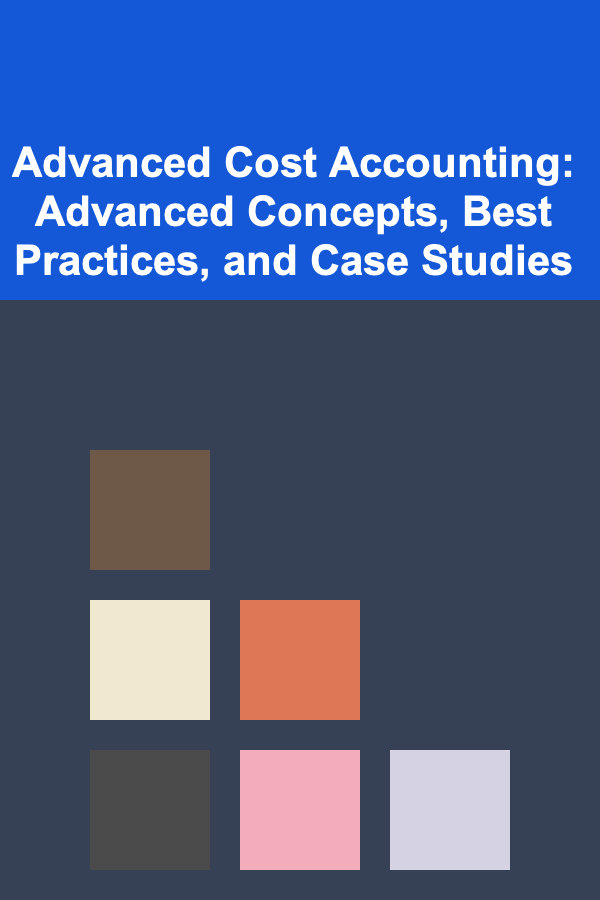
Advanced Cost Accounting: Advanced Concepts, Best Practices, and Case Studies
ebook include PDF & Audio bundle (Micro Guide)
$12.99$5.99
Limited Time Offer! Order within the next:

Cost accounting is a pivotal element in the decision-making process for any organization. While basic cost accounting concepts like direct costs, indirect costs, and standard costing lay the foundation, advanced cost accounting dives deeper into intricate methodologies, strategic analysis, and value-added decision-making. This guide will explore advanced cost accounting concepts, best practices for implementation, and real-world case studies that demonstrate how companies apply these techniques to optimize cost structures, improve profitability, and enhance efficiency.
Advanced Cost Accounting Concepts
1. Activity-Based Costing (ABC)
Activity-Based Costing (ABC) is one of the most prominent advanced concepts in cost accounting. Unlike traditional costing methods, which allocate overhead costs based on arbitrary measures like direct labor hours or machine hours, ABC identifies the activities that drive costs and assigns overhead based on actual consumption of resources. This provides a more accurate reflection of the true costs of products or services.
How ABC Works:
- Identify Activities: List all the activities that incur costs in the organization, such as order processing, product design, or customer service.
- Assign Costs to Activities: Determine the cost drivers for each activity. For instance, if the cost driver is the number of orders processed, the cost of order processing will be allocated based on how many orders a product or service generates.
- Allocate Costs to Products: Assign costs to products based on their use of these activities. This method helps eliminate the distortions that can arise from traditional costing methods.
Benefits of ABC:
- More Accurate Cost Allocation: ABC reflects the complexity of modern businesses, where overhead costs are often driven by factors other than just direct labor or machine hours.
- Improved Profitability Analysis: By providing a clearer picture of the true cost of each product, ABC helps businesses identify unprofitable products and services, enabling them to focus on high-margin areas.
- Cost Control: ABC helps pinpoint areas where inefficiencies exist, allowing for targeted cost reduction efforts.
2. Target Costing
Target costing is a pricing strategy that determines the desired cost for a product based on competitive market prices, customer expectations, and desired profit margins. Unlike traditional cost-plus pricing, where a markup is added to the cost, target costing works backward from the price at which a product will be sold in the market.
How Target Costing Works:
- Market Research: Identify the target price based on competitive analysis and customer expectations.
- Desired Profit Margin: Determine the desired profit margin or return on investment.
- Calculate Target Cost: Subtract the desired profit margin from the target price to calculate the target cost for the product.
- Cost Reduction: If the current cost exceeds the target cost, management must find ways to reduce costs through product design changes, process improvements, or cost-effective sourcing.
Benefits of Target Costing:
- Market-Driven: Ensures that the product is priced competitively, while still maintaining profitability.
- Focus on Cost Reduction: Forces organizations to streamline processes and innovate in order to meet cost targets, fostering a culture of continuous improvement.
- Aligns Product Design with Customer Expectations: Encourages companies to balance cost control with delivering value to customers.
3. Lean Accounting
Lean accounting is an extension of lean manufacturing principles to the accounting function. It aims to simplify and streamline accounting processes to provide real-time, actionable information, and eliminate waste. Lean accounting focuses on reducing unnecessary paperwork, improving the accuracy of cost data, and ensuring that financial reports reflect the realities of the production floor.
Key Principles of Lean Accounting:
- Value Stream Costing: Instead of allocating costs based on traditional cost centers, lean accounting assigns costs to value streams that represent the flow of value from raw materials to finished products.
- Simplified Reporting: Focuses on fewer, but more meaningful, reports that help managers make informed decisions quickly. For instance, the focus may shift from a traditional profit and loss statement to reports that track the efficiency and profitability of specific value streams.
- Continuous Improvement: Encourages companies to constantly assess and improve their accounting practices to align with lean principles, driving both operational and financial efficiency.
Benefits of Lean Accounting:
- Real-Time Decision-Making: By reducing the time lag in financial reporting, managers can act more quickly to adjust operations and processes.
- Improved Cost Visibility: Lean accounting gives managers a clearer understanding of costs associated with value streams, enabling them to focus on the most impactful areas.
- Waste Reduction: Eliminates unnecessary accounting tasks that add little value, streamlining the process and reducing administrative overhead.
4. Kaizen Costing
Kaizen costing is a concept rooted in the Japanese philosophy of continuous improvement ("Kaizen"). This approach focuses on making incremental cost improvements over time, rather than trying to achieve drastic cost reductions all at once. Kaizen costing involves setting small, achievable cost reduction targets on a regular basis and involving employees at all levels in the process.
How Kaizen Costing Works:
- Set Improvement Targets: Establish modest cost reduction goals that are achievable within short periods (e.g., monthly or quarterly).
- Involve Employees: Engage employees in cost-saving initiatives, encouraging them to contribute ideas for improving efficiency or reducing waste.
- Track Progress: Monitor the progress of cost reduction efforts and adjust strategies as needed.
- Reinvest Savings: The savings achieved through Kaizen costing are often reinvested into the business to support further improvements or new initiatives.
Benefits of Kaizen Costing:
- Sustainable Improvement: The focus on small, incremental improvements helps organizations avoid drastic changes that could disrupt operations.
- Employee Engagement: By involving employees in the process, Kaizen fosters a culture of ownership and continuous improvement across the organization.
- Cost Control: Helps to control costs over the long term, making cost reduction a consistent part of the company's operations.
Best Practices in Advanced Cost Accounting
To implement advanced cost accounting techniques effectively, organizations should adhere to several best practices:
1. Integrate Cost Accounting with Strategic Planning
Advanced cost accounting should not exist in a vacuum. To drive business success, cost accounting should be integrated with strategic planning processes. For instance, by incorporating activity-based costing or target costing in the strategic planning process, management can make more informed decisions about product pricing, resource allocation, and long-term investments.
2. Foster Cross-Functional Collaboration
Cost accounting is not only the responsibility of the finance department. Successful implementation of advanced cost accounting techniques requires close collaboration between finance, production, marketing, and operations teams. For instance, value stream costing and lean accounting can only be successful if the entire organization is aligned on the importance of continuous improvement and cost control.
3. Continuously Monitor and Update Costing Systems
As business environments evolve, so too should costing systems. It is essential to regularly evaluate the effectiveness of cost accounting methods and tools. For example, if market conditions change, a company using target costing may need to adjust its target costs or pricing strategies. Similarly, as technology evolves, organizations should leverage automation and AI tools to improve cost accuracy and efficiency.
4. Invest in Technology
Modern technology, such as enterprise resource planning (ERP) systems and advanced data analytics tools, can significantly enhance the effectiveness of advanced cost accounting methods. These tools can automate data collection, streamline reporting, and provide deeper insights into cost structures. Additionally, AI and machine learning algorithms can be used to predict future costs, identify inefficiencies, and optimize resource allocation.
Case Studies of Advanced Cost Accounting in Action
Case Study 1: Toyota's Use of Kaizen Costing
Toyota is a prime example of a company that successfully integrates Kaizen costing into its operations. Toyota's philosophy of continuous improvement is embedded in its cost management practices, where small, incremental cost savings are targeted on a regular basis. By setting monthly cost reduction targets and involving employees in the process, Toyota has consistently improved its operational efficiency and maintained its competitive advantage in the automotive industry.
Case Study 2: General Electric's Adoption of Activity-Based Costing
General Electric (GE) implemented Activity-Based Costing (ABC) to more accurately allocate overhead costs and gain a clearer understanding of product profitability. Before ABC, GE struggled with distorted cost allocations that hindered decision-making. By adopting ABC, GE was able to allocate overhead costs more accurately to its products, improve cost transparency, and make better pricing and investment decisions.
Case Study 3: Dell's Use of Target Costing
Dell Computer is known for its use of target costing to maintain competitive pricing in the technology market. By working backward from the target price that consumers are willing to pay, Dell establishes a target cost for each product. This method allows the company to continuously assess production efficiency and innovate in design, while ensuring that its products remain competitively priced without sacrificing profitability.
Conclusion
Advanced cost accounting techniques, such as Activity-Based Costing, Target Costing, Lean Accounting, and Kaizen Costing, offer powerful tools for companies to gain deeper insights into their cost structures, improve profitability, and enhance operational efficiency. When combined with best practices like cross-functional collaboration, strategic alignment, and continuous monitoring, these advanced concepts can drive long-term success and competitiveness in any industry.
By examining case studies from leading companies, we can see that the successful application of these advanced cost accounting methods results in smarter decision-making, more efficient processes, and sustained profitability. As businesses continue to navigate an increasingly complex financial landscape, advanced cost accounting will remain a critical function for ensuring financial health and operational excellence.
Reading More From Our Other Websites
- [Home Family Activity 101] How to Make a Family Vision Board for the Year Ahead
- [Home Holiday Decoration 101] How to Incorporate Sustainable Decorations into Your Holiday Home
- [Home Family Activity 101] How to Encourage Family Members to Try New Hobbies
- [Home Renovating 101] How to Make Your Home Feel Bigger with Smart Renovations
- [Organization Tip 101] How to Create Fun and Educational Home Routines
- [Home Staging 101] How to Create a Welcoming Entrance for Home Staging
- [Home Soundproofing 101] How to Soundproof Your Apartment Walls Without Construction
- [Organization Tip 101] How to Create a Meal Prep Station for Cooking Convenience
- [Organization Tip 101] How to Create a Memory Jar for Sharing Stories
- [Organization Tip 101] How to Schedule Regular Family Meetings for Open Communication

How to Create an Investment Strategy for Financial Independence
Read More
Optimizing Online Retail: Strategies for Growth and Success in E-commerce
Read More
How to Design for Adaptive AI Systems
Read More
How to Cook with Healthy Fats: A Comprehensive Guide
Read More
10 Tips for Navigating the Biomedical Engineering Job Market
Read More
10 Tips for Using 3D Modeling for Product Design
Read MoreOther Products

How to Create an Investment Strategy for Financial Independence
Read More
Optimizing Online Retail: Strategies for Growth and Success in E-commerce
Read More
How to Design for Adaptive AI Systems
Read More
How to Cook with Healthy Fats: A Comprehensive Guide
Read More
10 Tips for Navigating the Biomedical Engineering Job Market
Read More